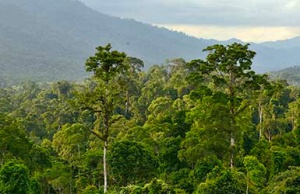Mention the word biodiversity and most people will automatically imagine a wild habitat unaffected by human influence, something like this:

These people wouldn’t probably think about the biodiversity at the doorstep, or even the micro-organisms living on the balcony.

In the age where urbanisation is an ever expanding process (shown here), focusing on the biodiversity in city landscapes is a vital process as nature is shown to have a positive effect on human health, both physically and and psychologically. This also seems like on of the few ways to still keep the city inhabitants in contact with nature on a more regular basis.
A major challenge in increasing biodiversity in urban areas is the dynamics between humans and these organisms. As a desert is a very dry and nutrient-poor environment, so is the city a harsh environment for species populations to stabilize due to the pressure we exert on them. This leads to the selection of certain species who can adapt and thrive in such an environment. Take for example the pigeons (more specifically the rock pigeon): these birds used to live and mate around cliffs, and with the surge of big and tall buildings in the city these pigeons could use this new ecosystem as their habitat. Not to mention the fact that there is an abundance of food in the city, which meant they could flourish leading to the current ‘plagues’ in cities all over the world.
The big catch to that is that other species who have more difficulty to survive are being pushed out of the city, which poses a threat on maintaining biodiversity. These organisms not only face threats of the human inhabitants but also the generalist species such as the pigeons, seagulls and rats. For organisms who find it difficult to survive in the city, there is a demand for a more subdued, stabilized habitat. This is where urban planning proves meaningful. The challenge is to construct parks and also keep these areas connected to provide enough space for these species to live and reproduce.
We also need to look at constructions which are being used by several organisms and find ways to optimize these for their users. A good example of this is the starling, which is currently under threat in Leiden not only because of bird predators and domestic cats, but also due to the fact that holes in old buildings are being closed more frequently and new buildings are constructed more tightly. With this starlings are under threat and they don’t have a safe space to hide. A simple countermeasure to this trend is simply to provide a safe space for these birds.
The city needs to become more than a hub for human housing and interaction, it needs to become a hub for other wildlife as well. An ecosystem is ‘healthy’ when there are a lot of different species so it can take some blows without getting KOed. And even though cities were originally built with only humans in mind, the fact remains that we need nature closer to us and nature is at the doorstep, we only have to make it feel welcome at home.
Thank you for sharing this. I definitely agree that urban planners and architects should take the importance of biodiversity into account while developing an area. Cities that do have an abundancy of nature are termed ‘biophilic cities’ (http://biophiliccities.org/biophiliccities.html). These cities stimulate people to go into nature and create a stronger tie between people and their natural environment. Maybe if people themselves start seeing the wide range of personal benefits they can get from nature, they start caring more about the importance of biodiversity.
LikeLike
Nice post! I also definitely agree with you that we shouldn’t have to see city and nature as two different conceptions. Urban planning deserves more attention. Especially because the amount of people living in an urban population is rapidly increasing and because biodiversity is necessary for a solid and good functioning ecosystem. The services which an ecosystem delivers are essential for human life and well-being. But even if urban planning will be a general thought in future, I’m still a little bit worried about the biodiversity on Earth in total. All cities have more or less the same kind of atmosphere and as how I see urban planning now, cities will get thereby the same type of biodiversity as well. Do you think that urban planning could make a city as exceptional in the variety of life as untouched nature can make an area?
LikeLike
I think this is a very nice idea that I think not many people realize. Animals in cities are often perceived as dirty or annoying. By focusing on the value of biodiversity in the city I think this mindset can be changed, even though it will probably take a while. Furthermore I realize that urban environments might attract the same type of biodiversity, but maybe this is different in other countries where the temperature different and the surrounding areas have different type of animals. I imagine this has limits though.
I also wonder how this shift in thinking could be best accomplished. Probably the government would have to take a leading role (in view of their prominent role in city planning) here in providing a good example, information and cooperating with building companies.
LikeLike